Editorial: Are we drugging our water?
Published 9:42 am Monday, July 7, 2014
Emphasizing the importance of agriculture, efforts such as Farm to Table work on getting our youth — and adults who should know better — to appreciate the work of farmers who put bountiful food on our tables.
Just pulling a carrot from the ground, washing it off and then eating it gets us a lot closer to appreciate nature and its value.
Now if we can just do the same for drinking water.
In an extensive national survey involving 118 wells in Minnesota, researchers found that about one third of them contained antibiotics, detergents or other contaminants. The statewide survey was conducted by the U.S. Geological Survey and the Minnesota Pollution Control Agency.
These chemicals, suspected of coming from landfills, septic systems and sewage treatment plants, were not found in surface waters but rather in the deep aquifers of our state.
We hasten to say that no chemicals found exceeded present drinking water quality standards but in some cases, certain antibiotics, antihistamines and flame-retardants that were found have no standards.
Not surprisingly, the source of these contaminants comes from us — consumers using prescription and over-the-counter medicines, lotions, detergents, and plastic-making ingredients.
And it comes from manufacturers. For instance, plastic microbeads used in cosmetics and lotions don’t break down and get into our waterways.
In a report by Minnesota Public Radio, the 118 wells tested are among those the MPCA monitors regularly, and they were chosen because of their assumed vulnerability to this kind of contamination, said Sharon Kroening, research scientist at the MPCA. Some were in the Twin Cities area, some near St. Cloud and others in north central, northwestern and southeastern Minnesota.
The report hypothesizes that these chemicals are coming from a number of different sources including wastewater systems, agricultural and storm runoffs and leaking municipal sewer lines.
This report is not meant to ring any alarm bells but clearly it means we as consumers need to be more aware of not just what we consume but how we dispose of our consumables.
One of the authors noted that we could be making better choices on such things as lotions. “Do we really need one that has a fragrance?”
More to the point, however, is how we dispose of our products, especially prescription medicines.
The city of Mankato has a drug drop box available 24-hours a day at the Public Safety Center for disposal of prescription and non-prescription medications. Another is located at the Blue Earth County Justice Center. Both points collected 2,664 pounds in the last year.
Just as food doesn’t come from grocery stores, water doesn’t come from bubblers. We need to be more aware of our impact on the water supply to ensure it remains healthy for all of us to consume.
— Mankato Free Press, June 29




